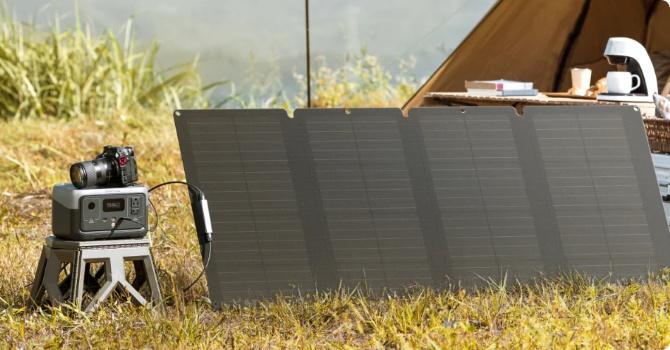In today’s tech-driven world, a reliable power source is essential. But what about when you’re outdoors? Whether camping, flying drones, or on the road, portable power stations have you covered.
The Importance of Portable Power Stations for Outdoor Adventures

Outdoor adventures give us a chance to disconnect from our routine and reconnect with nature. However, entirely disengaging from our devices isn’t always feasible or desirable. Phone for communication, camera for photos, drones for aerial shots, cooking appliances – all powered by portable stations. Each of these devices requires power, and that’s not something readily available in the great outdoors.
Enter the portable power station, a game-changer for outdoor enthusiasts. With their help, you can keep your devices powered up, no matter where you are. Designers create them compact, efficient, and lightweight, providing ample electricity. Some are portable solar generators, harnessing sunlight for virtually limitless power during the day.
Moreover, not only are these devices invaluable for camping or hiking, but they also prove useful in emergency scenarios. A portable power station jump-starts a dead car battery, reducing stress. Drone pilots use them for on-field battery recharging, enhancing productivity.
Searching online for the best portable power station for camping or a portable power station near me will yield numerous results. The trick is to understand your specific needs, the conditions you’ll be using the power station in, and choose a model that meets those requirements. As you venture into the outdoors, the last thing you want is to be let down by a flat battery. A reliable portable power station can make your adventure more enjoyable, more efficient, and indeed more adventurous.
What a portable power station is and how it works
A portable power station, also known as a portable battery generator, is a battery-powered device that provides power for electrical devices. The concept is straightforward: it stores electrical energy, like a large power bank, and then converts it into a form suitable for your devices, usually AC or DC. Depending on the model, it can be charged using a wall outlet, a car charger, or even solar panels. Its portability makes it ideal for outdoor activities, emergencies, or any situation where conventional power sources are inaccessible. The variety of output ports, such as AC outlets, DC ports, and USB ports, allows it to power or charge multiple devices at once.
Understanding Your Power Needs
Embarking on your outdoor adventure with a portable power station involves more than just packing it along with your gear. An integral part of the planning process is understanding your power needs. Underestimating your power requirements can lead to an abrupt disruption of your adventure, while overestimating can mean carrying unnecessary weight and volume.
Estimating Power Needs for Different Outdoor Activities
Your power needs primarily depend on the devices you plan to use. These can range from smartphones, laptops, and cameras to drones, cooking appliances, and camping lights. Each of these devices has a specific power requirement, usually expressed in watts (W).
To estimate your total power needs, list down all the devices you plan to power or charge, then look up their power ratings (usually available in the product manual or online). Multiply the power rating of each device (in watts) by the number of hours you plan to use it. Adding these numbers will give you an estimate of your total power requirement.
For instance, if you’re planning to charge a smartphone (approx. 10W) for 2 hours, a laptop (approx. 50W) for 3 hours, and run a camping light (approx. 5W) for 4 hours, your total power requirement would be around 200 watt-hours.
Importance of Considering Both Peak Power and Sustained Power
While estimating your power needs, it’s crucial to consider both peak power and sustained power. Sustained power is the maximum power that a power station can output continuously, while peak power is the maximum power it can provide for short periods, usually to start up devices with electric motors.
For instance, a mini fridge may need high initial power to start but significantly less power while running.
Understanding the power requirement of your devices and the peak and sustained power output of your portable power station ensures that your power source will adequately serve your needs throughout your outdoor adventure.
Top Brands and Models in the Market
Portable power stations have become increasingly popular, leading to a range of products from various manufacturers. Here’s a brief overview of some leading brands and models:
Brief Overview of Leading Brands
- EcoFlow: Known for innovative design and advanced battery technology, EcoFlow offers portable power stations suited for a range of needs.
- Jackery: A renowned name in the field, Jackery specializes in providing outdoor green power solutions, known for their reliability and efficiency.
- Goal Zero: With a focus on renewable energy, Goal Zero offers solar-ready portable power stations, perfect for extended outdoor trips.
- Anker: An established brand in the portable power sector, Anker’s power stations stand out for their compact size and powerful output.
- Bluetti: Bluetti offers a range of power stations known for their high capacity, multiple output options, and durability.
Key Models and Their Features
EcoFlow Delta: Offers a 1260Wh capacity with multiple output options, quick charging capability, and solar charging compatibility.
Jackery Explorer 500: Features a 518Wh capacity, multiple output ports, and the ability to charge via AC, DC, or solar power.
Goal Zero Yeti 400: This model features a 396Wh capacity, versatile output options, and a built-in display for easy monitoring.
Anker Powerhouse II 400: With a 388.8Wh capacity, multiple output options, and a compact design, it’s perfect for portable power needs.
Bluetti AC50S: Offers a 500Wh capacity, diverse output options, wireless charging, and solar charging capability.
Link:
400 watt peak output explorer 290wh portable power station
EcoFlow Delta Mini: Redefining Portable Energy Solutions for the Outdoor Enthusiast
What is the best for portable power stations? Top 3 outdoor power stations
Practical Tips for Using a Portable Power Station Outdoors
As wonderful as portable power stations are, their efficiency and lifespan largely depend on how well you use and maintain them. Here are some practical tips for using a portable power station outdoors:

Keeping Devices Charged and Managing Power
The first rule of managing power with your portable station is to understand your usage and needs. Keep a tab on the power ratings of your devices and how long you plan to use them. Remember to switch off and disconnect devices when not in use to save power.
Conservation is key in outdoor situations where the next recharge could be days away. Some power stations have a built-in power management system that provides information about output and remaining battery life; this can be instrumental in managing power efficiently.
When planning your usage, prioritize devices. Essential devices that can affect your safety and communication should be top of the list. Less critical devices like entertainment systems, should be lower on the priority list.
Safety Considerations
While portable power stations are generally safe to use, it’s crucial to remember a few safety tips. Always keep the power station dry; as electrical devices, they can sustain damage from water or excessive moisture.Avoid exposing your power station to extreme temperatures as it could affect battery performance and lifespan.
Ensure that the ventilation ports are not obstructed, especially when the power station is in use. Obstruction can lead to overheating, affecting the performance and safety of the device.
Finally, avoid overloading your power station. While most have a built-in system to prevent overloading, it’s still essential to ensure you’re not connecting devices that collectively exceed the station’s maximum output.
Maintenance and Care
Regular maintenance can extend the lifespan of your power station. Clean the device occasionally, ensuring that dust or dirt doesn’t build up, especially in the ventilation ports.
When the power station is not in use, store it in a cool, dry place. Most manufacturers recommend recharging the power station every three to six months when not in use. This practice keeps the battery in good health.
Consider using a protective cover or casing for added protection, especially when using the power station in rugged outdoor conditions.
Remember, the longevity and performance of your portable power station lie as much in your hands as in the engineering of the device. A well-cared-for power station can be a reliable partner in your outdoor adventures for years to come.
The Future of Portable Power Stations
Portable power stations are evolving rapidly, driven by advances in technology and the increasing demand for clean, renewable energy. Here are some of the exciting changes we can look forward to:

Technological Advancements
Affordability and Accessibility: As technology continues to progress, we can expect portable power stations to become more affordable. A search for portable power station cheap will likely yield increasingly varied and high-quality options. Economical choices will enable more people to access this valuable resource, without compromising on performance or reliability.
Specialized Use Cases: Portable power stations, designed for cars, are versatile. They charge gadgets, jump-start vehicles, and power automotive accessories.
Compact Designs: The introduction of mini portable power station models indicates a trend towards more compact and lightweight designs. These smaller power stations are easy to carry, making them perfect for camping, hiking, or other outdoor activities where portability is key.
Specific Device Compatibility: Some portable power stations of the future may specifically cater to popular devices. As portable car air conditioner units gain popularity for instance, we may see power stations that can efficiently and effectively power these devices for extended periods.
The Role of Renewable Energy, Especially Solar Power

As society becomes increasingly aware of the importance of sustainability, renewable energy sources like solar power are playing a bigger role in portable power solutions.
Already, many portable power stations can be charged via solar panels, allowing users to harness the power of the sun to recharge their devices. As solar technology advances, we can expect these systems to become even more efficient, storing more energy in less time.
Solar power isn’t the only renewable energy source being explored, however. Wind and water energy could also become integrated into future power stations, making them even more versatile and eco-friendly.
In conclusion, the future of portable power stations is bright. Advancements in technology and a focus on sustainability will make these devices even more accessible, versatile, and integral to our daily lives.Whether you’re off on an adventure or need a reliable power source at home, the portable power station of the future is sure to deliver.

